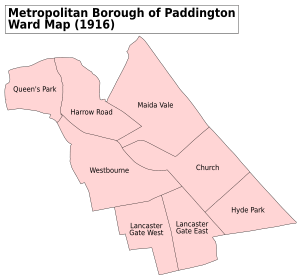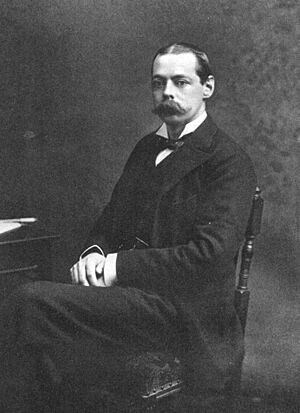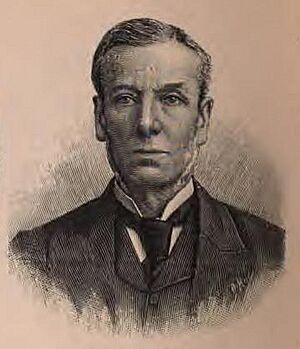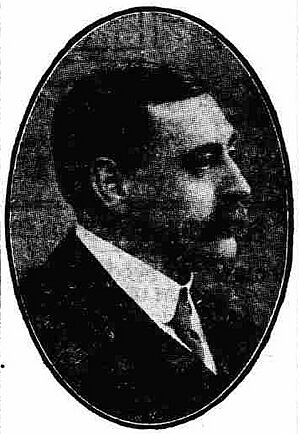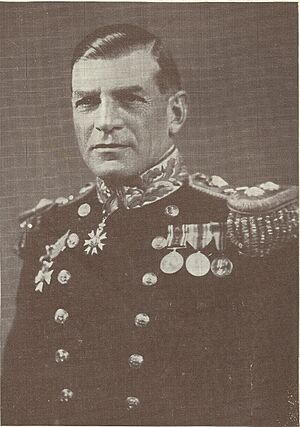Paddington South (UK Parliament constituency) facts for kids
Quick facts for kids {{{Name}}}[[{{{Type}}} constituency]] |
|
|---|---|
| [[Image:{{{Map1}}}Constituency.svg|120px|]] [[Image:England{{{Map2}}}.svg|120px|]] |
|
| {{{Name}}} shown within [[{{{Entity}}}]], and {{{Entity}}} shown within England | |
| Created: | {{{Year}}} |
| MP: | {{{MP}}} |
| Party: | {{{Party}}} |
| Type: | House of Commons |
| County: | [[{{{County}}}]] |
| EP constituency: | [[{{{EP}}} (European Parliament constituency)|{{{EP}}}]] |
Paddington South was a special area in London that elected one Member of Parliament, or MP, to represent it in the UK Parliament. It was a busy city area, mostly home to wealthy people. One of its most famous MPs was Lord Randolph Churchill. The constituency existed from 1885 until February 1974.
Contents
Where Was Paddington South?
The Paddington South area was first created in 1885. It covered the southern part of the Paddington area in London. Its borders were Bayswater Road and Kensington Gardens to the south, Chepstow Place and Ledbury Road to the west, Harrow Road, Westbourne Terrace, and Praed Street to the north, and Edgware Road to the east.
In 1918, the borders changed a bit. The northern edge moved further north to the Grand Union canal. This change brought in new areas like Little Venice, Paddington railway station, and Paddington Basin.
Even with these small changes, the main parts of Paddington South stayed the same for many years. In 1969, it was decided that Paddington South and Paddington North would join together to form a single Paddington constituency. This happened in 1974.
What Was the Area Like?
Paddington South was a mix of different neighborhoods, but it was generally a well-off area.
- The Hyde Park Estate in the east was built on land that used to belong to the Bishop of London. It was a rich area, and in the 1950s, many of its houses were updated.
- West of Hyde Park, near Kensington Gardens, was Lancaster Gate. This area also had many grand buildings, some of which were later turned into hotels.
- Further west, you'd find apartment blocks and stuccoed terraces. These were good quality homes built in the mid-1800s.
- On Queensway, the famous Whiteleys Department Store opened in 1863. It was a huge shopping place that was rebuilt between 1908 and 1912.
- Near the railway line to Paddington railway station, there were smaller houses and garden squares. This area changed over time, becoming less wealthy.
- Later, new housing estates like the Brunel Estate and the Warwick Estate were built in the area, replacing older buildings.
Overall, Paddington South saw some changes over the years, but it always had a large number of prosperous people living there.
Members of Parliament
Paddington South was always represented by a Conservative MP, except for a short period when an MP from the Empire Free Trade Crusade won.
| Election | Member | Party | |
|---|---|---|---|
| 1885 | Lord Randolph Churchill | Conservative | |
| 1895 by-election | George Fardell | Conservative | |
| 1910 | Henry Harris | Conservative | |
| 1922 | Douglas King | Conservative | |
| 1930 by-election | Ernest Taylor | Empire Free Trade Crusade | |
| 1931 | Conservative | ||
| 1950 | Somerset de Chair | Conservative | |
| 1951 | Robert Allan | Conservative | |
| 1966 | Nicholas Scott | Conservative | |
| Feb 1974 | constituency merged with Paddington North into Paddington | ||
Political History of Paddington South
This section looks at how elections happened and who represented Paddington South over the years.
Early Elections (1885-1910)
- 1885: Lord Randolph Churchill Elected
In 1885, Lord Randolph Churchill, a well-known Conservative politician, chose to run for MP in Paddington South. He won the election easily, even though two Liberal candidates ran against him. He was re-elected without anyone running against him in 1886 and 1892.
- 1895: George Fardell Takes Over
After Lord Randolph Churchill passed away in 1895, a special election (called a by-election) was held. George Fardell, a popular local Conservative, was chosen to be the candidate. He won without anyone running against him because he was so well-liked in the area. He was also re-elected unopposed in the general elections of 1895 and 1900.
- 1906: Fardell Wins Again
In 1906, George Fardell faced a challenger, Williamson Milne from the Liberal Party. Even though Milne ran, Fardell, who had been knighted (given the title "Sir"), won by a large number of votes.
- 1910: Henry Harris Becomes MP
In 1909, Sir George Fardell decided to retire. The Conservatives chose Henry Harris, a local council member, as their new candidate. He won the election in January 1910 and again in December 1910, both times against a Liberal candidate named F. T. H. Henlé.
Mid-Period Elections (1918-1935)
- 1918: Harris Re-elected Unopposed
In the 1918 "coupon" election (a special election after World War I), Henry Harris was re-elected without anyone running against him.
- 1922: Douglas King Wins a Tough Race
In 1921, Sir Henry Harris announced he would retire. The Conservatives chose Douglas King. However, another candidate, Ernest Sawyer, ran as an "Independent Conservative." This made the election very interesting. Despite the challenge, Douglas King won by a good margin.
- 1923-1929: King's Easy Wins
Douglas King continued to win elections in Paddington South. In 1923, he won against a Liberal candidate. In 1924 and 1929, he was re-elected without anyone running against him, showing how strong the Conservative support was in the area.
- 1930: A Surprising By-election
In 1930, Douglas King sadly passed away. A by-election was held, and it was a very lively contest. The Conservative Party's chosen candidate, Sir Herbert Lidiard, faced a strong challenge from Vice-Admiral Ernest Taylor, who was supported by the "Empire Free Trade Crusade." Taylor won this election, which was a big surprise and showed how much influence newspapers and campaigns could have.
- 1931: Taylor Becomes Conservative MP
After his by-election win, Ernest Taylor's voting record in Parliament was very similar to a Conservative MP. The Conservative Party eventually gave him their official support. He won the 1931 general election easily against a Labour candidate, Lucy Cox.
- 1935: Taylor Wins Again
Ernest Taylor was re-elected in 1935, continuing his strong hold on the seat for the Conservatives.
Later Elections (1945-1970)
- 1945: Taylor's Last Win
After World War II, Ernest Taylor was re-elected in 1945. He won against Charles Wegg-Prosser, the Labour candidate.
- 1950: Somerset de Chair Elected
In 1947, Vice-Admiral Taylor decided to retire. The Conservatives chose Somerset de Chair as their new candidate. He won the election, keeping the seat for the Conservatives.
- 1951: Robert Allan Takes Over
After the 1950 election, Somerset de Chair decided not to run again. The Conservatives quickly chose Robert Allan as their new candidate. He won the election against Charles Wegg-Prosser, who ran for Labour again.
- 1955 & 1959: Allan's Continued Success
Robert Allan continued to represent Paddington South, winning easily in both the 1955 and 1959 general elections. He faced Charles Wegg-Prosser again in 1955, and Dennis Nisbet for Labour in 1959.
- 1964: Allan's Majority Shrinks
In 1964, Robert Allan won again, but his lead was smaller. This time, a Liberal candidate also ran, taking some votes from the Conservatives.
- 1966: Nicholas Scott Becomes MP
Robert Allan decided to step down in 1966. The Conservatives quickly chose Nicholas Scott as their new candidate. He won the election, but his lead was even smaller than Allan's had been in 1964.
- 1970: Scott's Final Win
The Paddington South constituency was getting smaller, and it was decided that it would merge with Paddington North. So, the 1970 election was its last. Nicholas Scott won again, increasing his lead slightly.
In February 1974, the Paddington South constituency was officially merged with Paddington North to form the new Paddington constituency.


